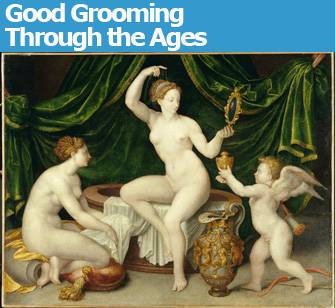 |
|
“Vénus à sa Toilette.” Anonymous. France, c. 1550. |
Those who decry the vanity of our era and mock the current obsession with Botox and other less-than-natural methods for physical enhancement need only pay a visit to the exhibition “Le Bain et le Miroir” to see that …
 |
|
“Vénus à sa Toilette.” Anonymous. France, c. 1550. |
Those who decry the vanity of our era and mock the current obsession with Botox and other less-than-natural methods for physical enhancement need only pay a visit to the exhibition “Le Bain et le Miroir” to see that nothing much has changed in the domain of human vanity over the past two millennia.
This is a two-part survey of body care and cosmetics through the ages, with Antiquity through the Middle Ages covered at the Musée de Cluny-Musée National du Moyen Âge and the Renaissance at the Musée National de la Renaissance in the Château d’Ecouen outside of Paris.
Both shows are surprisingly fascinating and stuffed with exhibits and facts that are interesting even for those, like me, who have no special interest in the history of beauty care.
Everyone knows that the Romans were bath-crazy and built elaborate public baths (the Cluny exhibition takes place in the building’s magnificent, just-restored frigidarium, with its high, vaulted ceiling), but who knew that they used what we usually think of as modern inventions, such as deodorants (made of alum and honey), moisturizers, skin whiteners, breath sweeteners and wrinkle creams. In the Middle Ages, women bleached their hair (blonds had more fun even then) and used hairpieces to create elaborate hairstyles that changed frequently with the fashions of the day.
The ubiquity of beauty products (even in the afterlife, given the number of objects found in grave sites) is illustrated by a wide variety of luxurious artifacts: cosmetics and perfume containers, mirrors, painted vases, statues, portrait busts, paintings, manuscripts, combs, pill boxes, perfume bottles and elaborate toiletry kits.
We learn that the battle between moralists and hedonists on the subject is nothing new, either. St. Augustine wrote that women should cover their hair and condemned makeup as “a miserable falsification,” while the Roman de la Rose praised long, flowing tresses. In art, a woman (often Mary Magdelene) depicted with long, flowing tresses was taken to be a sensualist and sinner, while a pious woman was veiled.
Scientific explanations describe how some of the often-toxic chemical products were made. Even though lead-based makeup was known by the Romans to be poisonous, for example, it continued to be used through the Middle Ages and killed many a woman who wore it.
Among the many fascinating objects on show are a fourth-century B.C. terracotta incense burner in the shape of a flower-woman and a hermetically sealed 11th-century jar that still contains cream with a human fingerprint on it.
For the second part of the exhibition, a trip to the Musée National de la Renaissance in the impressive Château d’Ecouen, less than half an hour by train from Paris, makes a very pleasant excursion, especially on a nice day, when you can walk through the forest from the train station to the château along well-signposted path.
The Renaissance part of the show offers a marvelous group of 16th-century prints depicting scenes in bathhouses, complete with voyeurs and naughty goings-on, by German artists, including Albrecht Dürer (who invented the genre) and Hans Sebald Beham. Many of these works were destroyed by censors. There are also a number of books on beauty secrets, filled with recipes for cosmetics, instructions for hair removal, etc. The apothecary Nostradamus, better known for his apocalyptic prophecies, wrote many of these little books (I guess even prophets have to pay the rent).
Other notable pieces in the Château d’Ecouen include artworks showing Aphrodite (or Venus) in her bath (a good excuse for depicting a naked woman, an idea inherited from the Greeks and Romans), including an anonymous painting with a strange composition showing a graceful Venus sleeping in the foreground while a servant sits sewing behind her, and a collection of clever little pommes de senteurs, hollow metal balls containing aromatic substances with supposed healthful effects (early aromatherapy) or appealing scents that were suspended from clothing.
The visit to the exhibition ends in the château’s basement baths, decorated with carved heads of grotesques that once adorned the Pont Neuf in Paris (they have been replaced by copies on the bridge).
Here’s a beauty tip from the Renaissance that may not find many takers today: slugs make great skin softeners.
Musée de Cluny-Musée National du Moyen Âge: 6, place Paul-Painlevé, 75005 Paris. Métro: Cluny la Sorbonne. Tel.: 01 53 73 78 16. Open Wednesday-Monday, 9:30 a.m.-5:45 p.m. Through September 21. Admission: €8.50 (€13 for combined ticket to Cluny and Ecouen). www.musee-moyenage.fr
Musée National de la Renaissance: Château d’Ecouen, 95440 Ecouen. Train from Gare du Nord to Ecouen-Ezanville (direction Persan-Beaumont or Luzarches par Monsoult), then bus 269 to Mairie/Eglise stop, (direction Garges-Sarcelles) or 20-minute walk through forest. Tel.: 01 34 38 38 50. Open Wednesday-Monday, 9:30 a.m.-12:45 p.m. and 2 p.m.-5:45 p.m. Through September 21. Admission: €6.50 (€13 for combined ticket to Cluny and Ecouen). www.musee-renaissance.fr
Buy related books and films from the Paris Update store.
More reviews of current art exhibitions.
Reader reaction
Click here to respond to this article (your response may be published on this page and is subject to editing).
© 2009 Paris Update
Favorite